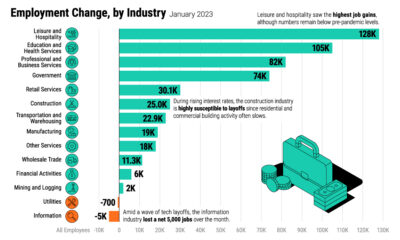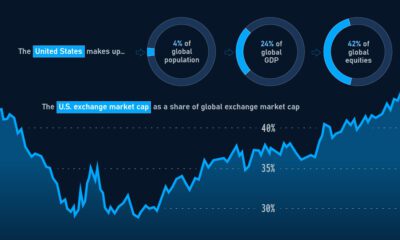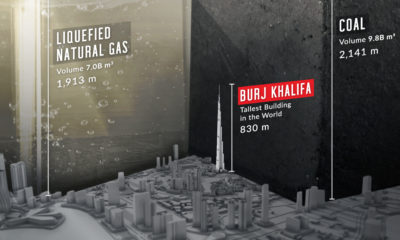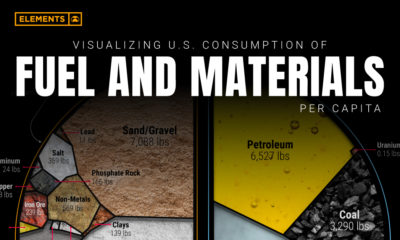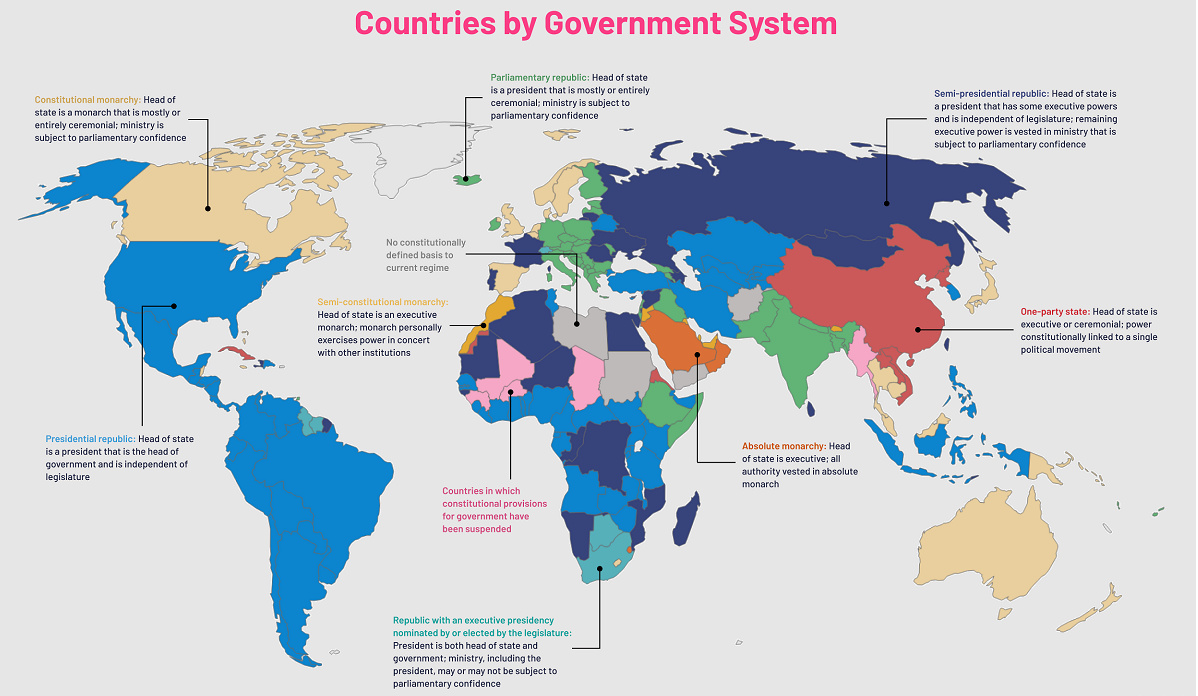In fact, if you had a globe that was 12-inches in diameter with mountains accurately depicted to scale, Mt. Everest would protrude from the surface at just the thickness of two sheets of paper. But while these rocky formations seem insignificant from the vacuum of space, for us that live on Earth they are much more relevant. Mountains dictate everything from weather patterns to travel routes, and these geographical features have helped shape human society as we know it.
Elevation, Exaggerated
Today’s short video loop comes from Reddit user newishtodc, and it shows the elevation profile of most of the continental United States. Pulling data from the USGS, the video loop actually exaggerates the scale of the topography so that elevation changes are much more pronounced. Instead of getting the “bumps on a surface” effect, it allows us to clearly see where the mountainous regions are. Here’s another version, this time including Alaska, Canada, and parts of Mexico:
Peak Elevation
As you likely noticed in both videos, mountains are particularly abundant on the western side of the continent. What you may not have realized, however, is that the highest peaks in North America are exclusively found in just three different subregions: Alaska (U.S.), Yukon (Canada), and the Cordillera Neovolcanica (Mexico). The 10 Highest Peaks in North America The highest mountain on the continent is Denali—although you may know it as Mt. McKinley. The name change was actually requested by Alaska back in 1975, but it wasn’t officially recognized by the U.S. government until 2015, coinciding with President Obama’s visit to the state. Denali isn’t the only massive mountain in Alaska, and the state is actually home to all 10 of the highest peaks found in the United States. The tallest mountain in California (Mt. Whitney, 14,505 ft) comes in at #11 on the U.S. list, while Colorado’s highest (Mt. Elbert, 14,440 ft) comes in the #14 spot nationally. Finally, the highest peak in Washington State (Mt. Rainier, 14,417 ft) is at #17.
Flatter Than a Pancake?
In the above animations, it’s also possible to see the regions that are dead flat. Despite having a reputation for being flatter than a pancake, Kansas isn’t anywhere near the flattest state. That particular designation goes to Florida, where the top elevation is just 345 ft (105 m) above sea level. Strangely, Florida is so flat that many of the tallest buildings in Miami easily surpass the highest natural point in the state in terms of height. The Panorama Tower, for example, is 868 ft (265 m) tall, making it more than double the height of the highest hill in Florida (Britton Hill). on Even while political regimes across these countries have changed over time, they’ve largely followed a few different types of governance. Today, every country can ultimately be classified into just nine broad forms of government systems. This map by Truman Du uses information from Wikipedia to map the government systems that rule the world today.
Countries By Type of Government
It’s important to note that this map charts government systems according to each country’s legal framework. Many countries have constitutions stating their de jure or legally recognized system of government, but their de facto or realized form of governance may be quite different. Here is a list of the stated government system of UN member states and observers as of January 2023: Let’s take a closer look at some of these systems.
Monarchies
Brought back into the spotlight after the death of Queen Elizabeth II of England in September 2022, this form of government has a single ruler. They carry titles from king and queen to sultan or emperor, and their government systems can be further divided into three modern types: constitutional, semi-constitutional, and absolute. A constitutional monarchy sees the monarch act as head of state within the parameters of a constitution, giving them little to no real power. For example, King Charles III is the head of 15 Commonwealth nations including Canada and Australia. However, each has their own head of government. On the other hand, a semi-constitutional monarchy lets the monarch or ruling royal family retain substantial political powers, as is the case in Jordan and Morocco. However, their monarchs still rule the country according to a democratic constitution and in concert with other institutions. Finally, an absolute monarchy is most like the monarchies of old, where the ruler has full power over governance, with modern examples including Saudi Arabia and Vatican City.
Republics
Unlike monarchies, the people hold the power in a republic government system, directly electing representatives to form government. Again, there are multiple types of modern republic governments: presidential, semi-presidential, and parliamentary. The presidential republic could be considered a direct progression from monarchies. This system has a strong and independent chief executive with extensive powers when it comes to domestic affairs and foreign policy. An example of this is the United States, where the President is both the head of state and the head of government. In a semi-presidential republic, the president is the head of state and has some executive powers that are independent of the legislature. However, the prime minister (or chancellor or equivalent title) is the head of government, responsible to the legislature along with the cabinet. Russia is a classic example of this type of government. The last type of republic system is parliamentary. In this system, the president is a figurehead, while the head of government holds real power and is validated by and accountable to the parliament. This type of system can be seen in Germany, Italy, and India and is akin to constitutional monarchies. It’s also important to point out that some parliamentary republic systems operate slightly differently. For example in South Africa, the president is both the head of state and government, but is elected directly by the legislature. This leaves them (and their ministries) potentially subject to parliamentary confidence.
One-Party State
Many of the systems above involve multiple political parties vying to rule and govern their respective countries. In a one-party state, also called a single-party state or single-party system, only one political party has the right to form government. All other political parties are either outlawed or only allowed limited participation in elections. In this system, a country’s head of state and head of government can be executive or ceremonial but political power is constitutionally linked to a single political movement. China is the most well-known example of this government system, with the General Secretary of the Communist Party of China ruling as the de facto leader since 1989.
Provisional
The final form of government is a provisional government formed as an interim or transitional government. In this system, an emergency governmental body is created to manage political transitions after the collapse of a government, or when a new state is formed. Often these evolve into fully constitutionalized systems, but sometimes they hold power for longer than expected. Some examples of countries that are considered provisional include Libya, Burkina Faso, and Chad.
